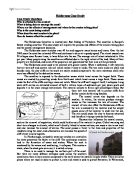Marine processes affect the coast by moving material around, through transportation and deposition. There are five main ways in which sediment can be transport from one place to another. These include, traction, saltation, suspension, solution and long shore drift. Traction is the movement of sediment along the seabed; particles roll or slide without leaving the floor. Saltation is a process where particles bounce along the seabed. Suspension occurs when the sediment moves though the water following the action of a current or wave without touching the seabed. Solution is slightly different in that the particles are actually dissolved in the water and move with the currents. With all these transport processes a number of landforms are created as energy is lost and material is deposited, for example salt marshes, tombolos, baymouth bars, offshore bars, spits, beaches, talus cones and cuspate forlands. However long shore drift is slightly different in its action, it actually moves sediment in the direction in which the waves crash on the beach. This can lead to one end of a beach to be built up and the other end to have a very shallow beach.
Wave processes can affect the coast by attacking the beaches and cliff bases through the sheer power of the water. Beaches are a natural protection for the cliffs, once marine processes have removed the beach there is very little protection from hydraulic pressure of the waves, this means some areas of the coast are more vulnerable to rapid erosion. Certain waves can destroy beaches and others can create them, destructive waves flatten beaches and constructive waves build beaches. In addition to wave type it is also the different types of currents in the water. For example, shore normal currents can change a beach profile, it is the current that moves the sediment on and off shore rather than the waves themselves.
In some areas of coastline, erosion occurs more rapidly than other areas, this can occur due to the rock types, human interference and orientation.
The white cliffs of Dover are made from chalk and are affected by carbonation; this is the process of carbonic acid reacting with the calcium carbonate to produce hydrogen carbonate and calcium carbonate that dissolve in water.
From this image you can see vegetation growing on the cliff face, this helps strengthen the rock by holding them in place by the roots. At this section of the cliffs there are no real defences against the sea, there is a lack of human impact, this can be seen as an advantage or disadvantage. With no protection the cliffs will retreat however there are no buildings on top of the cliffs so there is no real danger.
The process of long shore drift transports material down the beach. On this image we can see that the material has moved from A to B. Small pebbles are deposited and transported by the sea. These stones become part of the abrasion process that erodes the cliff face. Abrasion is the erosion of friction; material is scraped against the cliffs and causes it to weaken.
In 1999 Beachy Head experienced a 50ft deep chalk rock fall over a 200-yard section of the cliffs. Today there is no trace of the chalk that fell due its rapid erosion from the sea. Carbonation began almost instantly; in the above photograph you can see the murky colour of the water surrounding the fallen rock where the chalk is being dissolved. You may also notice the lighthouse that now stands solitary to anything else. Since 1832 when the lighthouse was built the cliffs have retreated 488ft.
In summary erosion on the coast is caused by the interactions of physical, chemical and human impacts. Some areas may be eroded faster than other due to the circumstances presented at the certain location.







